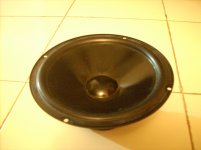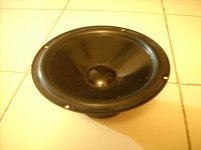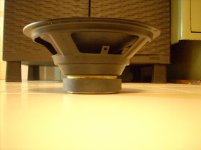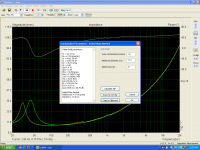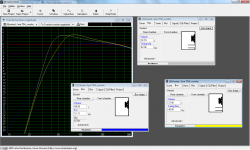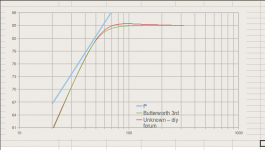A friend of mine gave me this unused diver.
I tried using WInISD, but could not understand what this driver must be designed for? When with closed enclosure, It gives over 200liters.
the TS are as follows.
Qts : 0.718
Vas: 57.7L
Fs: 40Hz
BL:6.2
xmax:3.8mm
(TS is provided by him. he says seller gave him those. )
What do you think what is this driver good for ?
I tried using WInISD, but could not understand what this driver must be designed for? When with closed enclosure, It gives over 200liters.
the TS are as follows.
Qts : 0.718
Vas: 57.7L
Fs: 40Hz
BL:6.2
xmax:3.8mm
(TS is provided by him. he says seller gave him those. )
What do you think what is this driver good for ?
Thank you all for showing interest in this thread.
8 inch.
I did simulate using WinIsd, but it limits lower to nearly 45 Hz. But the Xmax is low too. I think what you said would make it more practical. BTW max power rated is 75W
I am titaly new to TL, but would be interested. Can I request you to suggest me the enclosure parameters (rough).
Its a paper cone. I will upload Pic tomorrow morning. also I have plans to measure its TS myself. ( my desktop monitor, which has LIMP installed has some problem.)
thanks again to you all. More words are welcome.
OB woofer? How big is it?
8 inch.
Hi,
Its sealed mildly peaking (max efficiency alignnment woofer) probably 12"
Designed to work in a stuffed~ 30L (qbox=~ 1.2) to 60L (qbox = ~ 1).
rgds, sreten.
OB/IB is possible of course.
I did simulate using WinIsd, but it limits lower to nearly 45 Hz. But the Xmax is low too. I think what you said would make it more practical. BTW max power rated is 75W
Ditto TL.
GM
I am titaly new to TL, but would be interested. Can I request you to suggest me the enclosure parameters (rough).
Xmax only 3.3 would not be a very powerful sub unless it's pretty large diameter.
OB, Can you give us a few more hints? Size, material, picture? You are asking too much with too little.
Its a paper cone. I will upload Pic tomorrow morning. also I have plans to measure its TS myself. ( my desktop monitor, which has LIMP installed has some problem.)
thanks again to you all. More words are welcome.
Sounds like an excellent candidate for a big midrange in a big system [think 15" woofer or more]. Consider using it in a "holey" or open back system. The high Q units seem to perform well in those. Looks like an XO of around 150 - 200 might work for power handling. How high can it go? That can determine the cost of the tweeter.
Post some pics please.
Post some pics please.
Just a curious thought. did you want the pics for the size of magnet ?
I am habitual of listening drivers when I get them. I take my ear close to it. and play some music at a audible level. I heard many but this one had a good tight deep bass. and a clean vocal. I know its foolish to listen this way but just have put it here, if it could point out something.
I am habitual of listening drivers when I get them. I take my ear close to it. and play some music at a audible level. I heard many but this one had a good tight deep bass. and a clean vocal. I know its foolish to listen this way but just have put it here, if it could point out something.
Attachments
Last edited:
What do you think what is this driver good for ?
unfortunately maybe not so much
just a poor mix of design and manufacture
sorry for this grumpy post
but I have wasted too much time(and money) on crappy drivers
every time you hope, but reality usually catches up
cone, surround, chassis etc, it could all be fine
'sloppy motor design' simply aint good
small drivers, by nature a somewhat different matter
unfortunately maybe not so much
just a poor mix of design and manufacture
sorry for this grumpy post
but I have wasted too much time(and money) on crappy drivers
every time you hope, but reality usually catches up
cone, surround, chassis etc, it could all be fine
'sloppy motor design' simply aint good
small drivers, by nature a somewhat different matter
Maybe a woofer (with a small plate amp) for your workshop or garage?
I too feel if this driver can be used as a woofer or just some sloppy motor design. I tried the driver with one 28liters box which I had, Just to get some idea. but the bass was like hitting a filled tinbox.
as cal said before I fear this can be only good as a mid range to go with larger woofers.
I am waiting for weekend , so that i can repair my desktop monitor and measure its TS myself.
Got my desktop monitor repaired, so, the measured TS, below are those.
Thiele-Small parameters:
Fs = 42.37 Hz
Re = 7.00 ohms[dc]
Le = 4021.58 uH
L2 = 2159.70 uH
R2 = 35.79 ohms
Qt = 0.57
Qes = 0.70
Qms = 2.94
Mms = 30.58 grams
Rms = 2.769471 kg/s
Cms = 0.000461 m/N
Vas = 35.81 liters
Sd= 235.06 cm^2
Bl = 9.011816 Tm
ETA = 0.37 %
Lp(2.83V/1m) = 88.40 dB
Added Mass Method:
Added mass = 27.00 grams
Diameter= 17.30 cm
Thiele-Small parameters:
Fs = 42.37 Hz
Re = 7.00 ohms[dc]
Le = 4021.58 uH
L2 = 2159.70 uH
R2 = 35.79 ohms
Qt = 0.57
Qes = 0.70
Qms = 2.94
Mms = 30.58 grams
Rms = 2.769471 kg/s
Cms = 0.000461 m/N
Vas = 35.81 liters
Sd= 235.06 cm^2
Bl = 9.011816 Tm
ETA = 0.37 %
Lp(2.83V/1m) = 88.40 dB
Added Mass Method:
Added mass = 27.00 grams
Diameter= 17.30 cm
Attachments
Well, it's suitable for a relatively compact down-firing sub for relatively high tuned [< ~120 Hz] 'FR' mains and with its lower Qts than originally, more suited for MLTL [high aspect ratio vented alignment] in the same net Vb cab as the sub except for the driver, vent location than a traditional TL alignment.
GM
GM
Thanks GM for the reply.
" suitable for a relatively compact down-firing sub for relatively high tuned [< ~120 Hz]"
So, should hardly be called as sub. It could reach max to mid Bass, am I correct?
I found lot of drivers on net with Qts relatively high. Even 6" drivers too. Then I tried to find what people do with such kind of drivers, In most forums it was said this kind of drives make it good for car. But looking at them it looks like the driver designers or mfgs. must be having room use in their mind.
The following is what I found on other forum High Qts + Vented = Boomy Bass?
"For smaller boxes & drivers, you can often undersize the box, with the right tuning, get 1-3 db hump in the 60-90 range that will make small boxes sound big. Like Johnny said, depends on the driver. If the qts is 1.5, you probably won't make it happen. Something in the .5 to .8 range is a maybe."
Is it true ? Is this how cheap home theater subs are designed? Because I have heard them throwing huge bass, although it is not deep and natural.
Also , In other writeup it was mentioned that it makes no point in going for f3 below 40Hz , and no way below 30Hz unless room is treated. Or it will lead to boomy kind of bass. How true?
" suitable for a relatively compact down-firing sub for relatively high tuned [< ~120 Hz]"
So, should hardly be called as sub. It could reach max to mid Bass, am I correct?
I found lot of drivers on net with Qts relatively high. Even 6" drivers too. Then I tried to find what people do with such kind of drivers, In most forums it was said this kind of drives make it good for car. But looking at them it looks like the driver designers or mfgs. must be having room use in their mind.
The following is what I found on other forum High Qts + Vented = Boomy Bass?
"For smaller boxes & drivers, you can often undersize the box, with the right tuning, get 1-3 db hump in the 60-90 range that will make small boxes sound big. Like Johnny said, depends on the driver. If the qts is 1.5, you probably won't make it happen. Something in the .5 to .8 range is a maybe."
Is it true ? Is this how cheap home theater subs are designed? Because I have heard them throwing huge bass, although it is not deep and natural.
Also , In other writeup it was mentioned that it makes no point in going for f3 below 40Hz , and no way below 30Hz unless room is treated. Or it will lead to boomy kind of bass. How true?
Something different
My suggestion for these drivers is a third order sealed box - a bit odd I know. But the Kef reference 101's used this quite successfully.
How it goes is make a sealed enclosure with a Q of 1.0. This will be about 20 liters volume for your driver, given the specs from LIMP and assuming a 0.5 ohm series resistance for the crossover. Then add a capacitor in sereies with the bass driver - I calculate 800 uF for your driver. You can probably vary the capacitor around this a bit to taste - more capacitance will give a warmer bass response, less capacitance a tighter response.
The combination of the capacitor and box can make a third order butterworth response. The -3dB point is about 50 Hz with the values I've given.
The capacitor will be a large bypolar electrolytic cap. My advice is don't worry about the loss of quality from having an electrolytic in the signal path, if the drivers don't have a name and brand on them then losses in the capacitor shouldn't be your biggest quality concern.
The advantage of this is low excursion below the -3dB frequency and a small box. The low excursion suits your driver - because of this it will still be able to play music loud without running out of excursion.
Vented alignments are more normally used to make good bass in a small box but the Qt of the drive should be much lower to avoid a boomy bass response.
My calculated response is attached (The "Unknown - diy forum" trace) compared with an ideal 3rd order butterworth response.
Nick
My suggestion for these drivers is a third order sealed box - a bit odd I know. But the Kef reference 101's used this quite successfully.
How it goes is make a sealed enclosure with a Q of 1.0. This will be about 20 liters volume for your driver, given the specs from LIMP and assuming a 0.5 ohm series resistance for the crossover. Then add a capacitor in sereies with the bass driver - I calculate 800 uF for your driver. You can probably vary the capacitor around this a bit to taste - more capacitance will give a warmer bass response, less capacitance a tighter response.
The combination of the capacitor and box can make a third order butterworth response. The -3dB point is about 50 Hz with the values I've given.
The capacitor will be a large bypolar electrolytic cap. My advice is don't worry about the loss of quality from having an electrolytic in the signal path, if the drivers don't have a name and brand on them then losses in the capacitor shouldn't be your biggest quality concern.
The advantage of this is low excursion below the -3dB frequency and a small box. The low excursion suits your driver - because of this it will still be able to play music loud without running out of excursion.
Vented alignments are more normally used to make good bass in a small box but the Qt of the drive should be much lower to avoid a boomy bass response.
My calculated response is attached (The "Unknown - diy forum" trace) compared with an ideal 3rd order butterworth response.
Nick
Attachments
Last edited:
Thanks GM for the reply.
" suitable for a relatively compact down-firing sub for relatively high tuned [< ~120 Hz]"
So, should hardly be called as sub. It could reach max to mid Bass, am I correct?
I found lot of drivers on net with Qts relatively high. Even 6" drivers too. Then I tried to find what people do with such kind of drivers, In most forums it was said this kind of drives make it good for car. But looking at them it looks like the driver designers or mfgs. must be having room use in their mind.
The following is what I found on other forum High Qts + Vented = Boomy Bass?
"For smaller boxes & drivers, you can often undersize the box, with the right tuning, get 1-3 db hump in the 60-90 range that will make small boxes sound big. Like Johnny said, depends on the driver. If the qts is 1.5, you probably won't make it happen. Something in the .5 to .8 range is a maybe."
Is it true ? Is this how cheap home theater subs are designed? Because I have heard them throwing huge bass, although it is not deep and natural.
Also , In other writeup it was mentioned that it makes no point in going for f3 below 40Hz , and no way below 30Hz unless room is treated. Or it will lead to boomy kind of bass. How true?
You’re welcome!
Well, in today’s totally disabused jargon, anything tuned to < ~50 Hz applies, though in this driver’s case it should be good down to at least the lowest note on a piano [27.5 Hz]. The <~120 Hz referred to the highest XO point normally used for a HT’s LFE channel.
Historically, in prosound and consumer audio, the best bass was a chest thumping mid-bass where 40 Hz was ~ 12-24 dB down from 60 Hz. Indeed, most prosound still is and assume much of consumer audio also if not built to THX reference.
High Qts + Vented = Boomy Bass usually just means poorly designed [un]intentionally. Consider that at around a 0.4 Qts, Vb = Vas, Fb = Fs, so drivers with a lower Q typically need a Vb = < Vas and a Fb = > Fs and vice versa for drivers with a higher Qts, ergo in a proper alignment there will be no boom, though if there’s not enough power handling capability [Xmax], then hope the room will protect it and/or high pass it.
As they noted, another option is to design a max flat alignment, then shrink the cab as required to get the desired response.
WRT to really high Qts drivers, it takes well damped TLs to flatten them out.
Like most things, designing to F3 , F6, F12/whatever depends on the room shape and a host of other things, not the least of which is whether there’s going to be a sub system and where will it be located, so to make such a statement is too generalized to be of any use IME.
At the very least it should be something like ‘divide the longest room dimension into ½ the SoS to find the approximate point where room [‘cabin’] gain begins and start the speaker’s roll-off at this point’, so for 30 Hz the room dim. needs to be ~18.83 ft.
Really, without mapping at least the room’s basic acoustics it’s a crapshoot and why I always recommend building the largest speakers practical and tuned very low, then fine tune them as required at their room position. Of course the lazy way is to digitally EQ them, though this only works for a narrow ‘sweet spot’.
GM
- Status
- This old topic is closed. If you want to reopen this topic, contact a moderator using the "Report Post" button.
- Home
- Loudspeakers
- Multi-Way
- What is this driver good for ?
